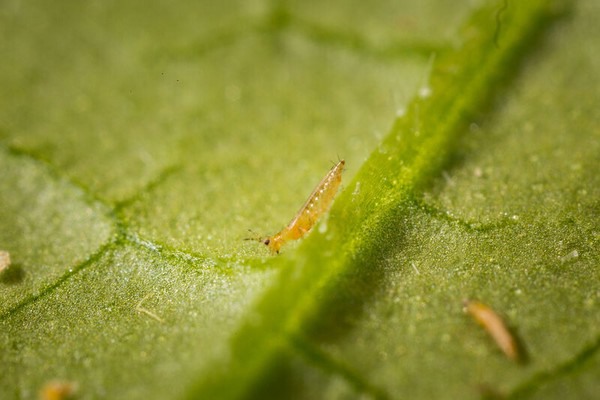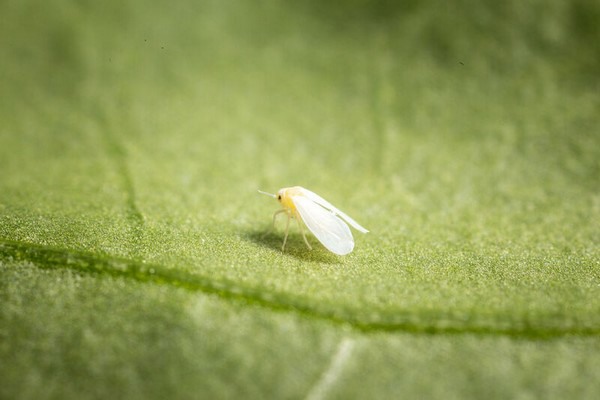Thrips and whitefly are two common pests that pose significant challenges to greenhouse cultivation worldwide. These pests feed on plant sap, causing damage, transmitting diseases, and reducing overall crop quality and yield.
Thrips – tiny pests with a rapid reproduction rate
Thrips are slender, tiny insects (0.5-1.4mm) with fringed wings, belonging to the order Thysanoptera. Adult thrips have wings that are typically folded along their backs when not in flight, making them difficult to see. They range in colour from light yellow to brown. Species include western flower thrips (Frankliniella occidentalis), onion thrips (Thrips tabaci), and impatiens thrips (Echinothrips americanus), where the western flower thrips (Frankliniella occidentalis) is the most damaging species.
Additionally, new thrips species are rapidly spreading over new territories, such as Europe, extending the list of these "most wanted" pests. Thrips parvispinus and Scirtothrips dorsalis are already causing damage in a wide range of protected crops, becoming significant threats as well.
Lifecycle and appearance of thrips
Thrips go through six developmental stages: egg, two larval instars, pre-pupa, pupal instar, and adult. The eggs are kidney-shaped with white or yellow shells. Before laying an egg, the female creates an opening in the plant tissue, depositing eggs in leaves, flower petals, and soft parts of stalks. Immediately after hatching, the larvae begin to feed on plant tissue on the underside of the leaf. The larvae are smaller than the adults and lack wings. Depending on the species, thrips pupate either on the plant or in the ground. The pre-pupal and pupal instars can be identified by their developing wing buds. Compared to the pre-pupa, the pupa has longer, more developed wing buds and longer antennae that curve back over the head. These instars do not feed and only move if disturbed. In the adult stage, both pairs of wings are fully developed, and the specific species of thrips can be identified based on the form, colour, and pattern of hairs. Female adult western flower thrips live up to 30 days and lay 2-10 eggs per day. At 20°C, development from egg to adult takes approximately 19 days. At 25°C, it takes 13 days. This entire lifecycle, from egg to adult, can occur rapidly under optimal conditions, allowing for quick population growth and potential damage to plants.

Thrips damage
Thrips cause damage to the plant by piercing the cells of the surface tissue and sucking out their contents, causing the surrounding tissue to die. These insects, when present in significant numbers, affect the plants' photosynthetic capability, thereby diminishing overall yield potential. On the blooms of vegetable crops, thrips feeding causes the formation of distinctive silvery white streaks upon the petals. Fruit injury varies according to the specific crop affected. For instance, in cucumbers, feeding triggers pronounced distortion and curling of the fruit, accompanied by the emergence of white streaks. On sweet peppers, thrips infestation shows as silvery or bronze streaks or spots on the fruit's surface. Additionally, thrips feeding on the calyx of fruit can cause its upward curling, making it susceptible to bacterial infections. Thrips are also responsible for the transmission of viruses, the best known of which is tomato-spotted wilt virus (TSWV), mainly transmitted by Frankliniella occidentalis.

Whiteflies – big impact on plant growth
A Whitefly is a moth-like insect belonging to the family Aleyrodidae. Whiteflies are not true flies but belong to the order Hemiptera (true bugs). Together with aphids and scale insects, they belong to the division Sternorrhyncha. In protected crops, the most common species are the greenhouse whitefly (Trialeurodes vaporariorum), and the tobacco whitefly (Bemisia tabaci). Also in outdoor crops whiteflies are causing significant damage, for example in cabbage and citrus.
Lifecycle and appearance of whitefly
Adult females live up to six weeks, and can produce up to 200 eggs, usually laying them on new plant growth on the under sides of leaves. Whiteflies undergo six distinct developmental stages: egg, first, second, third, and fourth larval instars, and adult. The late fourth larval stage is often called a 'pupa.' The eggs of both species are upright, spindle-shaped, and attached to a short pedicel. Upon hatching, the young larvae, known as 'crawlers,' have well-developed legs and antennae and actively seek a suitable spot on the leaf to feed. Once they find a feeding spot, they remain there for the rest of their larval development. The fourth larval instar, when the red eyes of the adult whitefly become visible, is also referred to as a 'pupa.' Whitefly species are most easily distinguished at the pupal stage. The adult whitefly emerges from the hardened cuticle of the pupa through a characteristic T-shaped opening created by splitting along pre-existing seams on the upper surface. Newly emerged adults have two pairs of transparent wings, which later become covered with a white, waxy powder, giving the insect its characteristic appearance. Adult whiteflies typically reside on the underside of young leaves where they lay their eggs.
Whitefly damage
Whiteflies pose a significant threat to poinsettias and greenhouse tomatoes, as well as a wide array of other plants including annuals, perennials, herbs, and vegetable bedding plants. Found predominantly on the underside of plant leaves, both nymphs and adults possess piercing-sucking mouthparts, enabling them to extract plant fluids. The appetite of whitefly larvae for plant sap results in the excretion of excess sugars as honeydew, with larger larvae producing substantial quantities. This honeydew excretion brings about several consequences. Extensive feeding can retard plant growth and cause leaves to wilt and drop. This significantly impacts fruit development and yield. The presence of honeydew also detracts from the visual appeal of crops, particularly ornamentals, while sticky honeydew deposits on fruit attract dirt and promote the growth of sooty moulds (Cladosporium spp.), rendering affected fruit unsalable and susceptible to rot. Whiteflies also serve as vectors for transmitting viruses between plants, posing additional risks to agricultural and horticultural crops.
The importance of strategic integrated pest management (IPM)
Thrips and whitefly pose significant challenges to greenhouse cultivation, but with an integrated approach to pest management (IPM), their impact can be minimized sustainably. A holistic approach not only helps to mitigate the development of resistance in thrips and whitefly populations but also promotes a healthier and more sustainable growing environment. Additionally, IPM strategies consider factors such as crop tolerance, pest thresholds, and environmental conditions, allowing for precise and efficient management tailored to the specific needs of each greenhouse operation. Regular monitoring, early detection, and proactive management are key to success in managing thrips and whiteflies in greenhouse cultivation.
For more information:
Koppert
[email protected]
www.koppert.com
